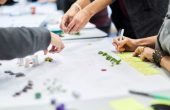Top designers do not emerge fully formed from nowhere. They have learnt their craft with rigour and fashion is as integral to their life as getting up in the morning.
For fashion educationalists the idea of learning “in” and “through” the subject is at the heart of our craft. A key aspect that drives the teaching of the subject is the idea that fashion students can aim to be the ultimate practitioner- the great fashioner designer, photographer, journalist, footwear designer or illustrator is part of what drives the teaching of the subject. We encourage students to immerse themselves totally in the subject so they are able to make the creative leaps required. This is essential if they are going to succeed in an intensely competitive and challenging industry.

Chichi Luo. BA (Hons) Fashion Design Technology: Womenswear
However educationalists also recognise that some students seek a wider application: they want to use the discipline of a creative education to learn how to apply their ideas, using them more broadly in the world and applying the education to other aspects of the economy or society that is an education “through” fashion. The current debates about the essential experiences of teaching and learning fashion today extends the parameters beyond what it is to be a great practitioner to looking at how issues such as sustainability and ethics are incorporated. How should we harness students’ creative practice to tackle the great issues facing our society and world today, making sure they are not only excellent designers, photographers, buyers or merchandisers but also ones that understand the ethical implications of their work and the industry? Should this sort of education be best achieved “in” the subject or “through” the subject?
In a creative education, practical and intellectual experiences are combined with the use of relevant technologies and media, so students come to realize their intentions and create a series of innovative, expressive and dynamic outputs. These outcomes are presented to a range of external and internal audiences to enable them to undergo a process of critical analysis and dialogue. All of its components, that are the principles, characteristics, skills and attributes, of a fashion education are thereby woven together so that, rather like the creative process itself, the learning itself builds an holistic experience that draws all the curriculum components together ensuring that the students understand how they inter-relate and can be applied to the world outside. The teaching and learning of fashion has evolved to develop a subject discipline where students not only develop their creative and aesthetic skills, talents and abilities, but also their critical, contextual and conceptual skills. The challenge for fashion and its educators now is whether we adjust our current teaching and learning systems to find space for issues around sustainability and ethics or do we seek to change the very way we teach to ensure that as we teach “in” the subject, sustainability and ethics are an integral part of the educational experience inherently bound up with the subject itself.
A clear example of how successfully sustainability can be integrated into the teaching and learning experience of students whilst celebrating their innovative and creative responses to making the fashion industry more sustainable is seen in the London College of Fashion Fashioning the Future competition. Run by the College’s Centre for Sustainable Fashion, this is an international competition devised to draw together ideas from students across the globe, it has just held its second set of awards. Hosted at London’s City Hall the work included clothes made from recycled cotton paper, exquisite design that need less laundering, hand crafted luxurious hemp satin pieces and hand-knitted pieces that are fastened onto basic wardrobe staples to create a completely adjustable wardrobe to cherish, these were just some of the winning ideas. The theme for Fashioning the Future 2009 challenged the fashion industry’s dependency on water, and the need to find radical ways to design, promote, retail and consume fashion, which alleviates this chronic dependency. Water is our most precious resource. From growing, ginning, spinning, to weaving, knitting, dyeing, finishing, and printing through to constructing, shipping, retailing, owning, washing and relinquishing, water is threaded throughout the journey of a garment. Access to clean water is essential to the health and well being of the human workforce that powers our industry as well as to the products that we produce. Water scarcity is one of the greatest threats to our civilisation. By focusing on water as part of this year’s awards, the idea was to inspire creative responses to one of the life threatening challenges of our era.
These awards are significant because they highlight the way student ideas and concerns about our global future can be channelled to target a particular issue. They highlight what can be achieved if we work together. No one designer, university, design discipline, visionary or pragmatist is going to be able to solve our environmental challenges.. It is only through collaboration and an interdisciplinary approach that sets sustainability at the heart of our educational practices that we can be assured that we will have graduates who understand how they can use their education to create a vibrant world, with communities fulfilled by their contribution to all of our lives.




